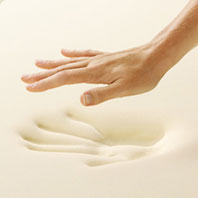We highly recommend going out and test some memory foam mattresses at the local retailer to get a sense of the overall feel, general construction and comfort you prefer. Memory foam mattresses are not for everybody and there is a good amount of people who can’t stand the molding feel. Make sure you like this unique feel and comfort before pulling the trigger online.
Be careful to read in between lines of marketing materials and product descriptions. Many of the so-called “memory foam mattresses” contain only a thin, low density layer of this foam, that doesn’t offer most of the advantages and benefits of memory foam. Higher quality foam mattresses will be made from at least 5lb/ft3, thus being quite heavy and more expensive. The denser the memory foam, the longer it will last, and the heavier it will be. Just like with any foam mattress if the product description doesn’t offer any density information try to lift it and “weigh” it relative to a different product. Less expensive products will by substantially thinner, generally made from only two layers – regular polyurethane foam support layer or support core (4-6") and thin layer of memory foam (only 1-2” ).
Some sleepers feel that they retain too much heat, as traditional memory foam tends to store more body heat than other kinds of mattresses. Gel foam manufacturers claim that their foams are much cooler, but they don’t say by how much and this may not be even noticeable by an end-user. In general, memory foam material will always be warmer because it is right underneath your body to get you the desired molding feel. You can provide a breathing insulation barrier (thicker cotton mattress pad) to lower heat but it will also alter the overall mattress feel.
Memory foam mattress works well with partners of different body weights, where they don’t disturb each other, since it completely eliminates motion transfer (wine glass commercial). Memory responds slower and some customers experience what they call a "quicksand" effect, where they feel like they are stuck and locked in a position and is hard for them to move. Please keep these minor drawbacks in mind when deciding which memory foam type is right for you. As much as we believe memory foam mattresses are great products they provide very distinct feel that will not make everyone happy.
Be aware of different warranties, most of them covering indentations larger than 3/4” over certain period of time. Find out how long is the mattress fully covered, and if the warranty is pro-rated, know what portion of the replacement cost you will be responsible for. Make sure you ask your store about exchange/return options and exchange/return costs. Read the fine print of the exchange/return policy before you place an order.
Most stores will declare that they cannot offer any discounts on premium memory foam beds and that their prices are fixed by manufacturers. There is some truth to this but double check with more stores because some retailers are more lenient than others. Always ask for a special financing offers or the incentive for not using one. Some retailers charge extra delivery and old mattress removal fees and those can add substantially to the final amount. Always ask for free gifts with a mattress purchase, it is always nice to get free pillows, mattress protector and set of sheets.

 Memory foam, also referred to as visco-elastic foam, is a material known for its superior pressure relieving quality, which helps reduce tossing and turning. It also provides even support by molding and contouring to the shape of your body, allowing for your spine to rest aligned in its natural position. It is made from polyurethane, consisting of tiny molecules – cells, that under pressure release air and thus creating a unique molding feel. It softens in reaction to body weight and body heat.
Memory foam, also referred to as visco-elastic foam, is a material known for its superior pressure relieving quality, which helps reduce tossing and turning. It also provides even support by molding and contouring to the shape of your body, allowing for your spine to rest aligned in its natural position. It is made from polyurethane, consisting of tiny molecules – cells, that under pressure release air and thus creating a unique molding feel. It softens in reaction to body weight and body heat.